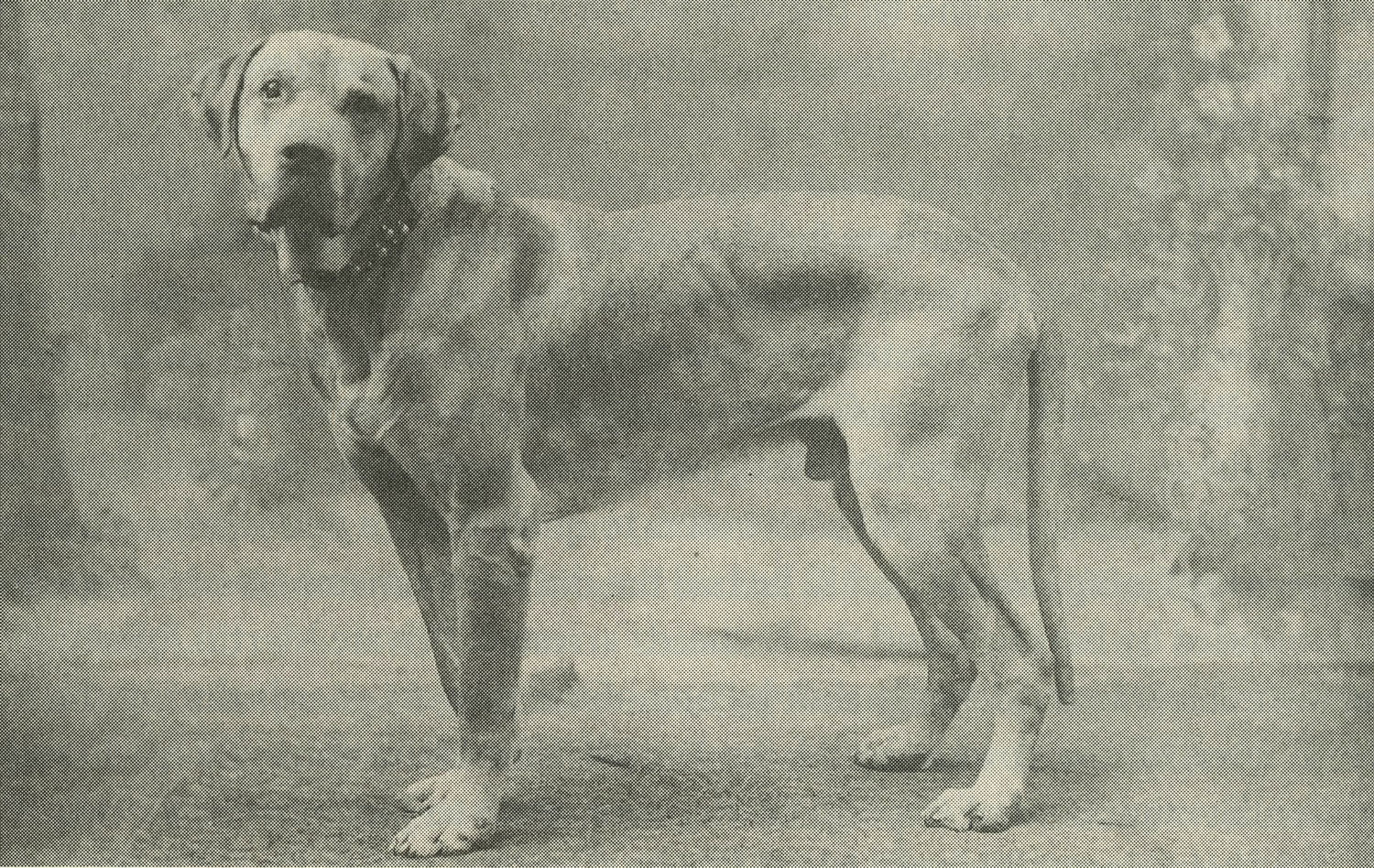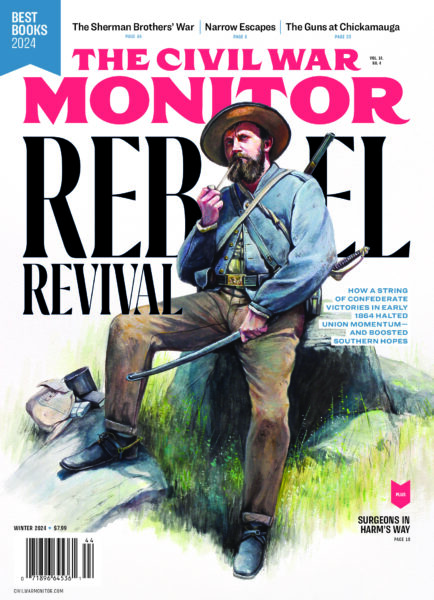Pete & Sam & AI
New reader here. I thought I’d let you know how much I enjoyed the Winter 2023 issue, especially the books section [“The Best Civil War Books of 2023,” Vol. 13, No. 4] and Elizabeth Varon’s article on James Longstreet’s friendship with U.S. Grant [“Friendly Foes”].
I already had a sense that Longstreet and Grant were close, and that their friendship started during their days at West Point. What I didn’t fully know was the nature and depth of their postwar relationship. Thanks to Professor Varon for a terrific article! Also, your AI cover image shows Longstreet taller than Grant. Was that truly the case? I’m assuming so if that’s what you produced.
Jeff Bowen
Via email
* * *
My son and I have been reading your magazine for a short time now and we like it because, as my son says, it contains “real history.” We read your articles assuming that the information they include, including old-looking pictures, are true.
The AI-generated image on the cover of the Winter 2023 issue is great and more like it would be OK, if it’s noted that it is not “real history.” Maybe the back of the magazine, like in the “Notes” section, would be a good place to acknowledge AI use in future.
Louis Cramer
Via email
* * *
Thank you for asking for input on the cover of the Winter 2023 issue. I was looking at it suspiciously before getting to your kind invitation to comment. Please put me on the side of those who do not wish to see altered images like this in a history magazine. It is already hard enough to tell truth from fiction in our daily lives. Please, don’t do this again. I call AI “Altered Images” that distort the truth.
Toni Criscuolo
Via email
* * *
I enjoyed the AI image on the cover of the Winter issue and thought it was a great lead-in to the article about Longstreet’s relationship with Grant: friends at West Point and during the Mexican War, adversaries in the Civil War, and friends again post-war! Keep up the great work!
Ernie Shepherd
Via email
Ed. Thanks to all for your feedback. To Jeff’s question: Yes, James Longstreet (6’2″) was distinctly taller than Ulysses S. Grant (5’8″). As to concerns about our use of AI-generated images of Longstreet and Grant in our winter issue, we get it. The line between “real” and “fake” feels like it’s never been fuzzier than it is today, and the rise of artificial intelligence—technology that, depending on whom you ask, is set to either improve our lives immensely or put us on a path toward something like human subjugation—has only exacerbated the situation. That said, we’ve been using AI for years to sharpen and colorize Civil War-era images, a practice now so routine among publishers of history books and magazines that it rarely if ever raises an eyebrow. In this instance, we admittedly went much further: Faced with the absence of any known photograph of the two old friends together, we thought it might be interesting—even fun—to have cutting-edge computer software attempt to create what such an image might have looked like. We have no plans to call again on AI for such a level of assistance in the Monitor. If and when we do, we promise to be (as we were in the winter issue’s editorial) crystal clear about it.
What If Lincoln Had Lived?
Allen C. Guelzo’s article in your Fall 2023 issue [“What If Lincoln Had Lived?,” Vol. 13, No. 3] was spot on. John Wilkes Booth did a terrible thing when he assassinated the president. I consider Lincoln the greatest loss of the Civil War. The injustices that were put on the South during Reconstruction would not have happened if Lincoln were still president. If Lincoln had lived, the South would not have been oppressed after the war; he would have helped the southern states rejoin the Union, thus the resentment the South felt as a result of Reconstruction would not have happened. Lincoln’s response when asked how the citizens of Richmond should be treated as he toured the city after its fall, “Let ’em up easy,” was forever true.
Charles Carroll
Fairhope, Alabama
Battle Cry at 35
Re: your Fall 2023 article “Popular and Peerless” [Vol. 13, No. 3], which commemorated the 35th anniversary of the publication of James McPherson’s Battle Cry of Freedom. I was working in an independent bookstore at a downtown location when the book was published. As in many small or medium-sized cities, the professional people all tended to live outside the downtown area and shopped at either our two satellite stores or the chain stores. So when I unpacked six copies of Battle Cry of Freedom, I went to the manager to see if there was a mistake. Six copies of a 900-page hardback from an academic press was more than we ever ordered at first, and I believe the book cost more than $30, expensive for a book at that time. The manager told me it was no mistake. “The Civil War has been a popular subject since the Ken Burns film, and I have a hunch this one will sell.” His hunch was right. We had to reorder Battle Cry of Freedom several times and sold an average of one copy a week for the next six months.
K.M. Dawson
Englewood, Ohio
Question From a Reader, Answered
Ed. In the Dispatches section of our Fall 2023 issue, we published the following question from Rick Heyer, who was hoping for feedback from fellow Monitor readers: “If Thomas ‘Stonewall’ Jackson had not been mortally wounded at Chancellorsville—and still had command of the Army of Northern Virginia’s Second Corps, as opposed to Richard Ewell getting it—would the Battle of Gettysburg have gone differently (especially concerning the first day’s fighting)?” Below are a few of the many responses we received.
No. Had Jackson survived it likely would have taken him months to recover from his wounds and amputation. He would not have returned to service until after the Gettysburg Campaign.
Daniel Newcomb
Via email
* * *
There probably would have been no Battle of Gettysburg, at least not on the day and time that it actually began, had Stonewall Jackson not died after Chancellorsville and had retained command of the Second Corps. The Army of Northern Virginia had been operating quite successfully overall since the Second Manassas Campaign with two large infantry corps under Jackson and James Longstreet, and the cavalry corps under Jeb Stuart. After Jackson’s passing, Lee divided the two existing infantry corps into three smaller corps under Longstreet, Richard Ewell, and A.P. Hill and ordered the Army of Northern Virginia into Pennsylvania. There is no reason to believe that there would have been any reorganization of the two infantry corps had Jackson lived. Why break up a winning combination? Coordinating an invasion of Pennsylvania with two large infantry corps instead of the three smaller ones would have confronted Lee with an entirely different set of strategic and logistical challenges, which in my view would have precluded the two armies from colliding at Gettysburg on the morning and afternoon of July 1, 1863.
Dennis Middlebrooks
Brooklyn, New York
* * *
Two points: First, Jackson would have shown more initiative at Gettysburg than Richard Ewell, as the former would not have been hesitant when Robert E. Lee wrote an order to take a position “if practicable.” Second, Jackson could have talked Lee out of ordering the ultimately disastrous Pickett’s Charge, Jackson having been a master of the flank movement. I think Jackson might have had more success than James Longstreet had in that effort.
Edward Keller
Middle Island, New York
* * *
Having walked the entire Gettysburg battlefield many times, it becomes clear that the three-day fight consisted of many individual battles at many different locations. The outcome of these individual battles is what persuaded Robert E. Lee, contrary to the thinking of his generals, to make the ill-fated Pickett’s Charge.
That said, though Lee put stock in his officers’ ideas and opinions, he was still the commander and clashed many times with James Longstreet and Jeb Stuart, among others. I have no doubt Lee would have acted the same way with Jackson, if he had been at Gettysburg.
Moreover, Jackson was only one man. To conclude that his battle prowess would have carried the day at Gettysburg is being disingenuous about the other fine officers and men that fought there.
Finally, the Army of Northern Virginia had supply and logistical problems during the Gettysburg Campaign that, in my opinion, doomed them from their first step on Pennsylvania soil. Even if Jackson had survived his Chancellorsville wounds and managed to change the outcome at Gettysburg, the army had been thrashed to the point of not being able to continue on, and therefore the Confederate victory would have been a hollow one, as they most likely would have had to abandon the field.
While it is an interesting question to ponder, Jackson would not have affected the outcome at Gettysburg—or the war in general, for that matter.
Michael Proper
Via email
 New Hampshire Veteran's Association
New Hampshire Veteran's AssociationOld Jep
Dogs of War
Re: the recent Monitor feature about the many roles dogs played during the Civil War [“Dogs of War,” Vol. 13, No. 2]. I found a photograph of “Old Jep,” the mascot of the 6th New Hampshire Infantry, when I was doing research for my book Men of Granite: New Hampshire’s Soldiers in the Civil War (2008). The New Hampshire Veterans’ Association built beautiful vacation homes on Lake Winnipesaukee, located at Weirs Beach, New Hampshire, after the war. The NHVA hosted many Grand Army of the Republic gatherings and offered veterans a place to stay for their reunions. Most of these homes are not in use now and several burned down, but one surviving home contains a treasure trove of photos and artifacts from the war.
Casually looking through these many images I came across a photo of a yellow Lab named Jep [pictured above] with a brief description on the back, and I knew I had to include it in the book. The description reads: “‘Old Jep.’ This yellow, long-tailed dog was the mascot of the Sixth New Hampshire Regiment, Company I. The company found the three-month-old puppy while at Roanoke, North Carolina, in 1862 and took the loyal dog everywhere over the next two years. ‘Old Jep’ was not seen after the engagement at Poplar Springs Church, Virginia, and it was assumed that he was killed in the battle.”
Duane Shaffer
Via email
Submit your Letters to the Editor at [email protected].


